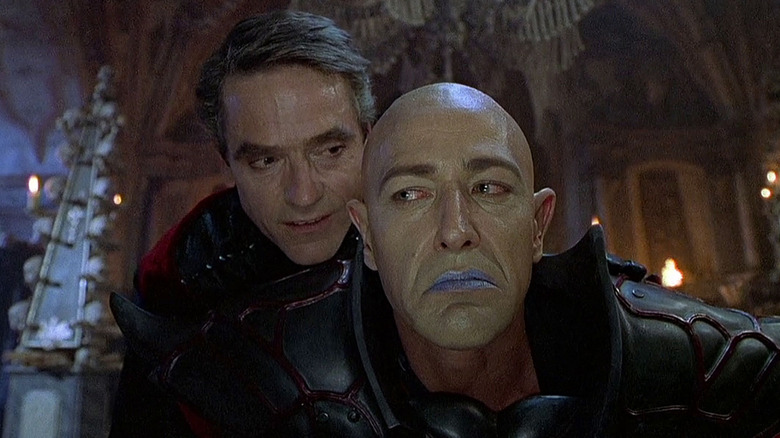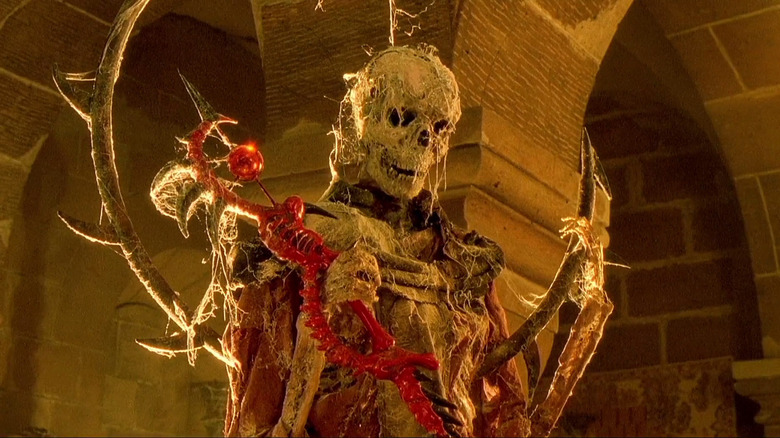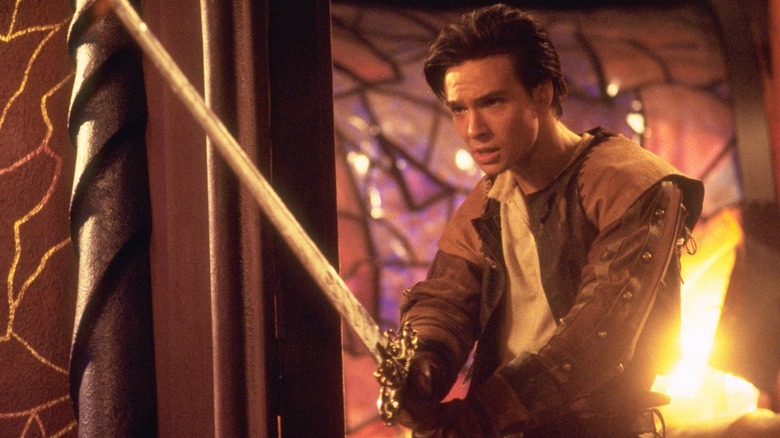Scraps From Sixteen Scripts Went Into The Original Dungeons & Dragons Film
The road to the 2000 "Dungeons & Dragons" feature film is a long, scary, and circuitous one. The story goes that in 1990, a 19-year-old kid named Courtney Solomon was able to arrange several conversations with TSR, Inc., the company that owned D&D, under the pretense that he was working on a college economics project. As detailed in a 2000 issue of Cinefantastique, Solomon obtained the film option for D&D after submitting a 30-page proposal as to how he would handle it. The initial dream was to make a truly enormous fantasy epic with a then-gigantic $100 million budget.
Over the years, however, the project fluctuated, with the high-profile failure of films like "Krull," "Willow," and "Dragonheart" giving studios cold feet. In 1997, TSR sold the D&D game to Wizards of the Coast, leading to additional strained negotiations as to the size and budget of the film project; One studio wanted a cheap straight-to-video film, another wanted a studio epic. A whole book could be written on the arduous task of bringing "Dungeons & Dragons" to the big screen.
Multiple scripts were penned throughout this process. Solomon first penned a draft as early as 1991, but by the time a final draft hit the screen, any previous ideas had been mashed into baby food. The final script was credited to Carroll Cartwright and Topper Lilien, but according to Solomon — who ended up directing the project — it was an amalgam of a decade's worth of drafts.
Indeed, in a 2012 retrospective interview with IGN, Solomon posited that the final script was an assembled scrapheap of ideas. This may be one of the contributing factors to the fact that the 2000 "Dungeons & Dragons" film is, not to put too fine a point on it, an utter s***show.
D&D, remixed
All told, it took nearly 11 years to get "Dungeons & Dragons" to the big screen, and the result was completely underwhelming. The film received hugely negative reviews (it has a 10% approval rating on Rotten Tomatoes), and often is included in conversations about the worst movies of all time. Since Solomon spent a great deal of time and energy assuring the film was made, he comes to its defense in the IGN interview. He doesn't argue that it was good, but he is frank about how good the film could have been and what went wrong along the way. The script was an issue, as it was a patchwork of ideas that Solomon had to more or less assemble on the fly. The filmmaker recalled:
"We went into filming with like sixteen different scripts and just worked with each for different scenes and schedules for security and of course to get the best possible mix."
"Dungeons & Dragons" stars Justin Whalin as a handsome thief named Ridley who runs afoul of an evil wizard named Profion (Jeremy Irons) who seeks to take over the world with an army of red dragons. Ridley assembles a team of ragtag heroes to gather magical items and eventually face Profion and his blue-lipped henchman Damodar (Bruce Payne). Also involved is a benevolent Queen (Thora Birch).
The nature of the "Dungeon & Dragons" game presented Solomon with some interesting creative challenges. Since the world of D&D is not set in a well-established fictional country (it's not mapped out like in Tolkein's "Lord of the Rings" novels), Solomon chose to focus on the characters. As it turns out, he had some very specific ideas as to which version of D&D he wanted to take those ideas from.
Advanced Dungeons & Dragons, 2nd Edition
The D&D game — a role-playing fantasy game which mixed dice-rolling, statistics, and character improv — was first pioneered in the late 1960s by Jeff Perren and Gary Gygax and first published as a set of rule books in 1974. The game quickly expanded into the more advanced spinoff called, fittingly enough, Advanced Dungeons & Dragons, and multiple versions were invented to make the game more friendly to novices. In 1989, AD&D grew into a second edition, an edition that this author recalls with clarity. It also appeared to be the version that Solomon wanted to most explicitly refer to when inventing character types for the D&D movie, as he referred to it by year. He said:
"It's a generic setting, not like Dragonlance or the others. Not a specific setting. It was meant to reflect the way players have always played the game and created their own campaigns, but I wanted to reflect the rules and character classes of the basic, basic, basic game circa 1991 which saw the release of the second edition rules set. That is when the script was written. Third edition came out in like 1993 and the latest edition of the rules will have to wait for the sequel."
"Dragonlance" is, incidentally, an unrelated spinoff of D&D set in its own kingdom called Krynn, which did have consistent characters and settings. The Drangonlance brand began in 1984 with its own adjunct game and novel, "Dragons of Autumn Twilight."
Despite the general failure of the 2000 film, it did warrant two straight-to-video sequels. Also, enough time has passed that a major studio is taking another crack at it: Paramount will release "Dungeons & Dragons: Honor Among Thieves" on March 3, 2023.


